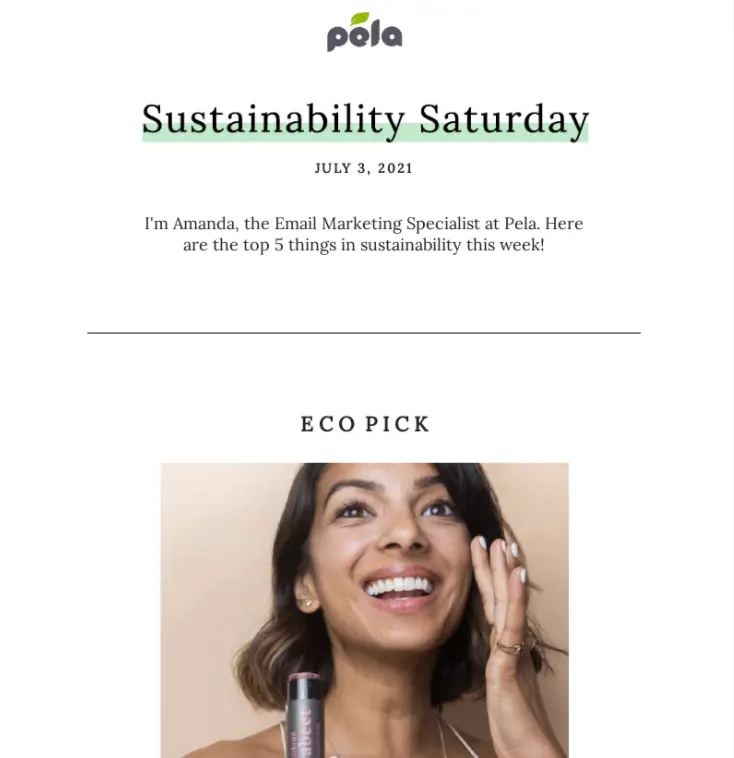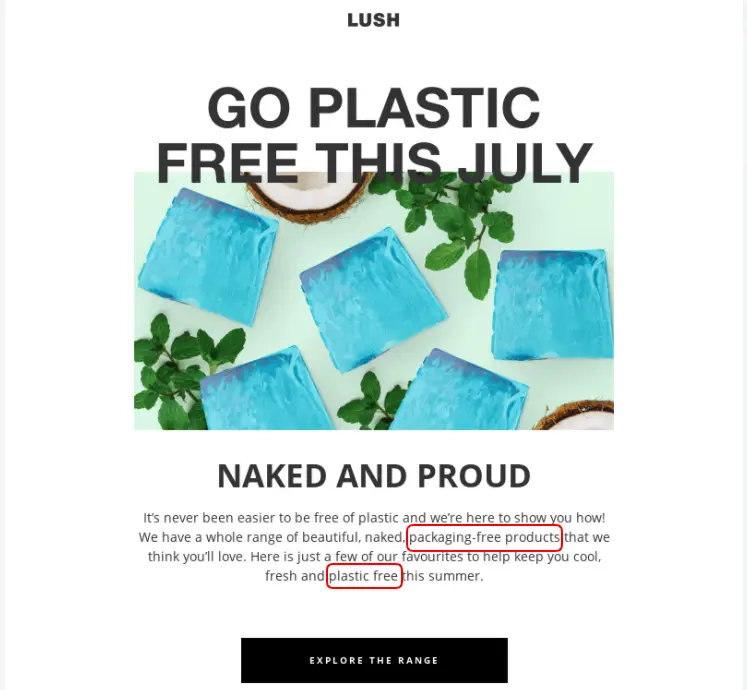As shoppers increasingly hold social causes in high regard, they look for products and brands that go along with their values. To illustrate my point, just consider the following statistics.
According to an IBM study, about six in ten consumers surveyed consider their shopping habits environmentally unfriendly and would like to change them. Eight out of ten cite the importance of sustainability, and nearly 70% of them are ready to pay more for brands that care about the environment.
You see that eco-friendly marketing strategies aren’t only good for the environment but are also beneficial for businesses. That’s why it’s high time to embark on the path of becoming green if you haven’t undertaken it yet.
In this article, we’ll talk about being “green” as a small business and analyze some big-name examples that might inspire you to start a sustainable marketing campaign.
Green Marketing or Greenwashing?
Green marketing involves producing and advertising environmentally friendly products. What goods can be sustainable?
For example, their production process may cause lower emissions. Or you may use post-consumer recycled materials for a product’s packaging. In addition, some businesses promote themselves as environmentally responsible by donating a portion of their profits to related initiatives such as tree planting.
These are all reasonable steps, but you need to back up your efforts. If not, you risk being accused of misleading or false advertising. It’s known as greenwashing.
These are marketing gimmicks where manufacturers disguise themselves as being green. In reality, they fail to explain why their garments, cosmetics, or other goods are less polluting than others.
Brands can leverage some external methods and complex strategies to appear sustainable, such as:
- craft packaging;
- natural colors;
- the “eco-friendly” and “natural” expressions;
- non-existent eco-certificates;
- to name a few.
One way to recognize deceptive marketing is using excessive buzzwords. Add the lack of transparency, and you’ll get a company that is sugarcoating its marketing in the pursue of sales.
Below, I’ve collected some practical strategies to promote small businesses that care about the environment.
How Small Businesses Can Start Eco-Friendly Marketing Campaigns
1- Go Digital
Digital marketing is a perfect solution for small eco-friendly businesses. Just look at how it’s far ahead of traditional marketing:
- less expensive;
- works faster;
- has a lower environmental impact;
- isn’t limited to a particular location.
For example, switching to digital ads is a low-cost alternative to print advertising that produces no trash. Or you can stop using direct mail and replace it with email marketing. The same goes for social media, allowing you to engage consumers and prospects in a very cost-effective way.
If you already have a solid online presence, consider switching to modern solutions, such as the headless commerce approach, progressive web apps, or optimize the website to be as fast as possible. Note that your website is also responsible for leaving a carbon footprint. So the easier it is for buyers to find products, the less time they spend online and the fewer resources it takes.
What if a small firm can’t give up printed coupon mailers? Small businesses should invest in building their email database to reduce direct mail.
Below you will find Pela Case’s email marketing campaign with sustainable trends and news. The company picks the top five sustainable news and sends them to its subscribers. This way, providing value to its conscious consumers and promotes the name.

2- Sustainable Workplace Practices
Prove your sustainable pledge with the work culture. Otherwise, how can a company care about the environment and neglect the rules within the office? Be transparent in terms of sustainable workplace conduct.
Sustainable workplace behavior includes:
- collaborating with suppliers that utilize ecologically friendly packaging;
- driving vehicles on renewable energy;
- sorting the trash and disposing of garbage without harming the environment;
- encouraging employees to bring their lunch (to illustrate my point, Nike launched a reusable dishware program at work to eliminate to-go boxes);
- placing trash cans in every office corner to make recycling easy;
- Holding company events as waste-free as possible.
How can you help your staff change their habits and become more environmentally conscious? For example, you may opt for electronic documents and other tools to reduce material usage. Or encourage employees to save energy by working near windows with natural light.
3- Use Eco-Friendly Packaging
Are you still brainstorming the ideas to make your product design sustainable? Then, it won’t be hard to adopt an eco-conscious approach to your packaging. Or you can operate the existing offer in the same way.
Let’s start with the question: is the packaging you’re utilizing still made of plastic? Plastic is a significant contributor to pollution and non-recyclable materials, so phase it out.
Yes, technological progress allows us to recycle some kinds of plastic. But you can’t rely on people to sort the trash or reuse the packaging for other purposes. Let alone many plastics can’t be recycled.
That’s why you should consider sustainable materials that are biodegradable and recyclable, such as:
- paper;
- cardboard;
- corn starch;
- bagasse paper;
- and so on.
Doing business with environmentally conscious companies, manufacturers, and partners is also a brilliant idea. Then evaluate your suppliers. Do they share your commitment to sustainability?
Another worthy move for small businesses is selling goods in “naked packaging,” or no packaging at all. That’s what is Lush is famous for, as you can see in the screenshot below. It’s an email newsletter telling about new products you can buy with no plastic contribution to the environment.

4- Put the Corresponding Price Tag
Handcrafted items are more expensive than mass-produced items, which doesn’t surprise us. So why should products developed with sustainability in mind be cheaper?
While this deliberate pricing may seem self-evident to you, some customers need explanations. What’s the value of your offer? Set a price tag appropriate to the market and explain why the price is higher than a competitor’s.
For example, you may work with sustainable suppliers or certified manufacturers. Or you may produce almost zero waste throughout the manufacturing process. The cost of the final product illustrates all these points.
As stated above, customers are willing to pay more for green products. It’s also essential that these goods aren’t tested on animals, and workers’ rights are respected. Let buyers know how this purchase influences their environmental effect, whatever justifies your pricing.
A case in point is Tide with its “50% more energy savings” approach. It produces laundry detergent, which is efficient in terms of water and energy use. For example, a low-sudsing formula or detergent that works in cold water. It enables consumers to save on their bills and have a less harmful effect on the environment.
5- Join Environmentally-Focused Initiatives
Extend your eco-friendliness beyond self-promotion. Use the company to voice your thoughts, participate in environmental activities, partner with sustainable organizations, and publicize these collaborations. It’s even better if you donate to a local charity.
How can participating in environmentally-focused events help? It allows you to raise your brand awareness and establish your image as an environmentally conscious corporation.
This way, you ensure benefits to all parties involved and the environment. Here are the ways to contribute to eco-friendly causes:
- making donations;
- volunteering;
- offering “green” sales incentives, such as planting trees or contributing a portion of a sale to an environmental group.
Below you can see a Tazo tea store example. The brand outlines how much money is donated to fight not just climate change (such as a partnership program with Intersectional environmentalists) but also social issues, such as racism.

Over to You
Green marketing is a rising but sure-to-stay trend. People are more concerned than ever before about saving the Earth and maintaining environmental health. That’s why companies follow the consumers’ demands and provide them with organic solutions.
How can business owners promote their growing companies with the help of green marketing? For example, produce organic products, utilize biodegradable and reusable packaging, or maintain eco-wise workplace behavior.
Build your service with sustainability in mind, use digital media to promote it, and support environmentally-focused initiatives. And you’ll see the results of your efforts sooner than you expected.



